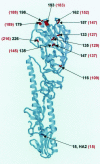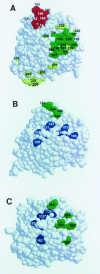Structural differences among hemagglutinins of influenza A virus subtypes are reflected in their antigenic architecture: analysis of H9 escape mutants
- PMID: 14671105
- PMCID: PMC303415
- DOI: 10.1128/jvi.78.1.240-249.2004
Structural differences among hemagglutinins of influenza A virus subtypes are reflected in their antigenic architecture: analysis of H9 escape mutants
Abstract
We used a panel of monoclonal antibodies to H9 hemagglutinin to select 18 escape mutants of mouse-adapted influenza A/Swine/Hong Kong/9/98 (H9N2) virus. Cross-reactions of the mutants with the antibodies and the sequencing of hemagglutinin genes revealed two minimally overlapping epitopes. We mapped the amino acid changes to two areas of the recently reported three-dimensional structure of A/Swine/Hong Kong/9/98 hemagglutinin. The grouping of the antigenically relevant amino acid positions in H9 hemagglutinin differs from the pattern observed in H3 and H5 hemagglutinins. Several positions in site B of H3 hemagglutinin are distributed in two sites of H9 hemagglutinin. Unlike any subtype analyzed so far, H9 hemagglutinin does not contain an antigenic site corresponding to site A in H3 hemagglutinin. Positions 145 and 193 (H3 numbering), which in H3 hemagglutinin belong to sites A and B, respectively, are within one site in H9 hemagglutinin. This finding is consistent with the peculiarity of the three-dimensional structure of the H9 molecule, that is, the absence from H9 hemagglutinin of the lateral loop that forms site A in H3 and the equivalent site in H5 hemagglutinins. The escape mutants analyzed displayed phenotypic variations, including decreased virulence for mice and changes in affinity for sialyl substrates. Our results demonstrate a correlation between intersubtype differences in three-dimensional structure and variations among subtypes in the distribution of antigenic areas. Our findings also suggest that covariation and pleiotropic effects of antibody-selected mutations may be important in the evolution of H9 influenza virus, a possible causative agent of a future pandemic.
Figures


Similar articles
-
Structure of antigenic sites on the haemagglutinin molecule of H5 avian influenza virus and phenotypic variation of escape mutants.J Gen Virol. 2002 Oct;83(Pt 10):2497-2505. doi: 10.1099/0022-1317-83-10-2497. J Gen Virol. 2002. PMID: 12237433
-
Restoration of virulence of escape mutants of H5 and H9 influenza viruses by their readaptation to mice.J Gen Virol. 2005 Oct;86(Pt 10):2831-2838. doi: 10.1099/vir.0.81185-0. J Gen Virol. 2005. PMID: 16186239
-
Monoclonal antibodies differentially affect the interaction between the hemagglutinin of H9 influenza virus escape mutants and sialic receptors.Virology. 2004 Nov 10;329(1):33-9. doi: 10.1016/j.virol.2004.08.002. Virology. 2004. PMID: 15476872
-
Epitopes in the HA and NA of H5 and H7 avian influenza viruses that are important for antigenic drift.FEMS Microbiol Rev. 2024 May 8;48(3):fuae014. doi: 10.1093/femsre/fuae014. FEMS Microbiol Rev. 2024. PMID: 38734891 Free PMC article. Review.
-
The antigenic architecture of the hemagglutinin of influenza H5N1 viruses.Mol Immunol. 2013 Dec;56(4):705-19. doi: 10.1016/j.molimm.2013.07.010. Epub 2013 Aug 7. Mol Immunol. 2013. PMID: 23933511 Review.
Cited by
-
Targets for the induction of protective immunity against influenza a viruses.Viruses. 2010 Jan;2(1):166-188. doi: 10.3390/v2010166. Epub 2010 Jan 14. Viruses. 2010. PMID: 21994606 Free PMC article.
-
Two-dimensional antigenic dendrogram and phylogenetic tree of avian influenza virus H5N1.FEMS Immunol Med Microbiol. 2012 Mar;64(2):205-11. doi: 10.1111/j.1574-695X.2011.00884.x. FEMS Immunol Med Microbiol. 2012. PMID: 22066850 Free PMC article.
-
Genetic and biological characterization of H9N2 avian influenza viruses isolated in China from 2011 to 2014.PLoS One. 2018 Jul 3;13(7):e0199260. doi: 10.1371/journal.pone.0199260. eCollection 2018. PLoS One. 2018. PMID: 29969454 Free PMC article.
-
H9 Influenza Viruses: An Emerging Challenge.Cold Spring Harb Perspect Med. 2020 Jun 1;10(6):a038588. doi: 10.1101/cshperspect.a038588. Cold Spring Harb Perspect Med. 2020. PMID: 31871234 Free PMC article. Review.
-
The emergence of new antigen branches of H9N2 avian influenza virus in China due to antigenic drift on hemagglutinin through antibody escape at immunodominant sites.Emerg Microbes Infect. 2023 Dec;12(2):2246582. doi: 10.1080/22221751.2023.2246582. Emerg Microbes Infect. 2023. PMID: 37550992 Free PMC article.
References
-
- Caton, A. J., G. G. Brownlee, J. M. Yewdell, and W. Gerhard. 1982. The antigenic structure of the influenza virus A/PR/8/34 hemagglutinin (H3 subtype). Cell 31:417-427. - PubMed
-
- Centers for Disease Control and Prevention. 1998. Update: isolation of avian influenza viruses from humans—Hong Kong, 1997-1998. Morb. Mortal. Weekly Rep. 46:1245-1247. - PubMed
-
- Daniels, R. S., S. Jeffries, P. Yates, G. C. Schild, G. N. Rodgers, J. C. Paulson, S. A. Wharton, A. R. Douglas, J. J. Skehel, and D. C. Wiley. 1987. The receptor binding and membrane fusion properties of influenza virus variants selected with anti-haemagglutinin monoclonal antibodies. EMBO J. 6:1459-1465. - PMC - PubMed
-
- Gambaryan, A. S., and M. N. Matrosovich. 1992. A solid-phase enzyme-linked assay for influenza virus receptor-binding activity. J. Virol. Methods 39:111-123. - PubMed
-
- Gambaryan, A. S., J. S. Robertson, and M. N. Matrosovich. 1999. Effects of egg adaptation on the receptor-binding properties of human influenza A and B viruses. Virology 258:232-239. - PubMed
Publication types
MeSH terms
Substances
Associated data
- Actions
- Actions
- Actions
- Actions
- Actions
- Actions
- Actions
- Actions
- Actions
- Actions
- Actions
- Actions
- Actions
- Actions
- Actions
- Actions
- Actions
- Actions
- Actions
- Actions
Grants and funding
LinkOut - more resources
Full Text Sources
Other Literature Sources
Molecular Biology Databases

